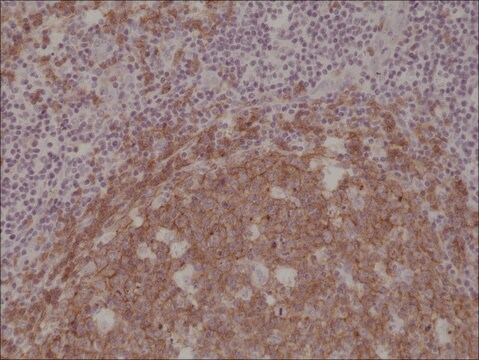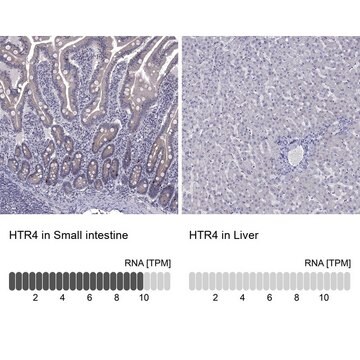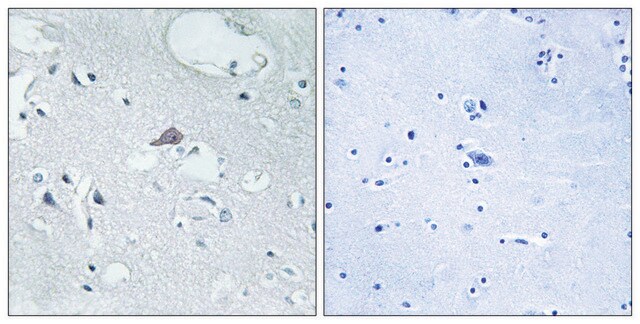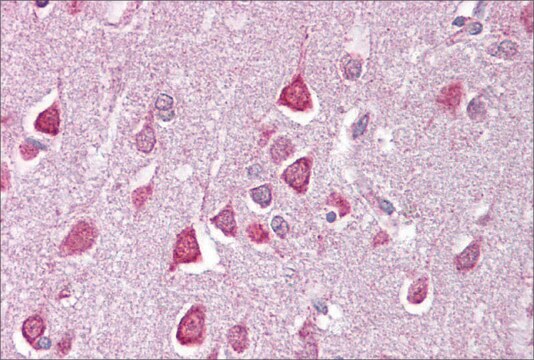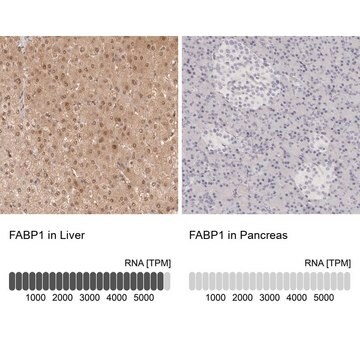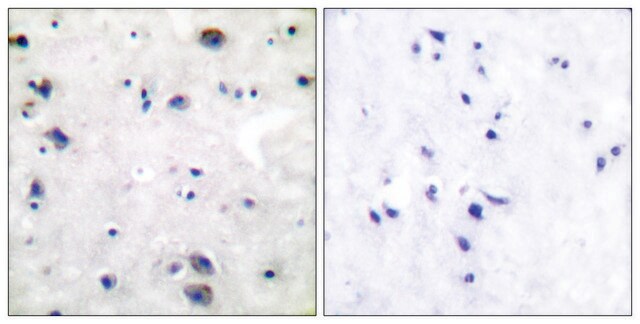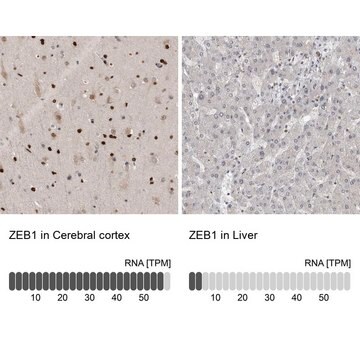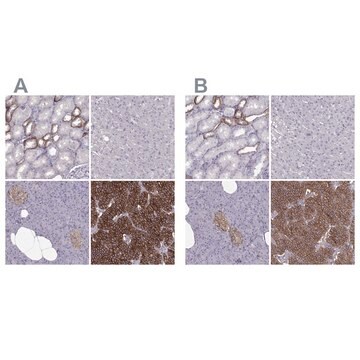추천 제품
생물학적 소스
rabbit
Quality Level
결합
unconjugated
항체 형태
affinity isolated antibody
항체 생산 유형
primary antibodies
클론
polyclonal
제품 라인
Prestige Antibodies® Powered by Atlas Antibodies
양식
buffered aqueous glycerol solution
종 반응성
human
기술
immunohistochemistry: 1:20- 1:50
면역원 서열
LTLLSVSARTGFCKKQQELWQRRKEAAEALGTRKVSVLLATSHSGARPAVSTMDSSAAPTNASNCTDALAYSSCSPAPSPGSWVNLSHLDGNLSDPCGPNRTDLGGRDSLCPPTGSP
UniProt 수납 번호
배송 상태
wet ice
저장 온도
−20°C
타겟 번역 후 변형
unmodified
유전자 정보
human ... OPRM1(4988)
일반 설명
The gene OPRM1 (opioid receptor μ 1) is mapped to human chromosome 6q24-q25. The gene spanning a length of 200kb contains 11 exons that yield 17 splice variants.
면역원
Mu-type opioid receptor recombinant protein epitope signature tag (PrEST)
애플리케이션
All Prestige Antibodies Powered by Atlas Antibodies are developed and validated by the Human Protein Atlas (HPA) project and as a result, are supported by the most extensive characterization in the industry.
The Human Protein Atlas project can be subdivided into three efforts: Human Tissue Atlas, Cancer Atlas, and Human Cell Atlas. The antibodies that have been generated in support of the Tissue and Cancer Atlas projects have been tested by immunohistochemistry against hundreds of normal and disease tissues and through the recent efforts of the Human Cell Atlas project, many have been characterized by immunofluorescence to map the human proteome not only at the tissue level but now at the subcellular level. These images and the collection of this vast data set can be viewed on the Human Protein Atlas (HPA) site by clicking on the Image Gallery link. We also provide Prestige Antibodies® protocols and other useful information.
The Human Protein Atlas project can be subdivided into three efforts: Human Tissue Atlas, Cancer Atlas, and Human Cell Atlas. The antibodies that have been generated in support of the Tissue and Cancer Atlas projects have been tested by immunohistochemistry against hundreds of normal and disease tissues and through the recent efforts of the Human Cell Atlas project, many have been characterized by immunofluorescence to map the human proteome not only at the tissue level but now at the subcellular level. These images and the collection of this vast data set can be viewed on the Human Protein Atlas (HPA) site by clicking on the Image Gallery link. We also provide Prestige Antibodies® protocols and other useful information.
생화학적/생리학적 작용
The gene OPRM1 (opioid receptor μ 1) encodes a μ opioid receptor that functions in pain perception and addiction to drugs of abuse, such as cocaine, nicotine, and alcohol. It serves as a target for opioid drugs, such as morphine, methadone and heroin, and opioid peptides, such as β-endorphin and endomorphins, and mediates their effects. Single nucleotide polymorphism A118G in this gene is associated with an inclination to drug addiction and lesser response to painful stimuli.
특징 및 장점
Prestige Antibodies® are highly characterized and extensively validated antibodies with the added benefit of all available characterization data for each target being accessible via the Human Protein Atlas portal linked just below the product name at the top of this page. The uniqueness and low cross-reactivity of the Prestige Antibodies® to other proteins are due to a thorough selection of antigen regions, affinity purification, and stringent selection. Prestige antigen controls are available for every corresponding Prestige Antibody and can be found in the linkage section.
Every Prestige Antibody is tested in the following ways:
Every Prestige Antibody is tested in the following ways:
- IHC tissue array of 44 normal human tissues and 20 of the most common cancer type tissues.
- Protein array of 364 human recombinant protein fragments.
결합
Corresponding Antigen APREST72740
물리적 형태
Solution in phosphate-buffered saline, pH 7.2, containing 40% glycerol and 0.02% sodium azide
법적 정보
Prestige Antibodies is a registered trademark of Merck KGaA, Darmstadt, Germany
면책조항
Unless otherwise stated in our catalog or other company documentation accompanying the product(s), our products are intended for research use only and are not to be used for any other purpose, which includes but is not limited to, unauthorized commercial uses, in vitro diagnostic uses, ex vivo or in vivo therapeutic uses or any type of consumption or application to humans or animals.
적합한 제품을 찾을 수 없으신가요?
당사의 제품 선택기 도구.을(를) 시도해 보세요.
Storage Class Code
10 - Combustible liquids
WGK
WGK 1
Flash Point (°F)
Not applicable
Flash Point (°C)
Not applicable
개인 보호 장비
Eyeshields, Gloves, multi-purpose combination respirator cartridge (US)
가장 최신 버전 중 하나를 선택하세요:
Anna Cieślińska et al.
Tumour biology : the journal of the International Society for Oncodevelopmental Biology and Medicine, 36(6), 4655-4660 (2015-01-27)
Structure-dependent μ-opioid receptor (MOR) activity is an important element in cancer opioid analgesic effectiveness. It is widely accepted that guanine (G) substitution for adenine (A) at OPRM1 gene sequence position 118 changes receptor glycosylation pattern. This is associated with decreased
O Bartošová et al.
Physiological research, 64 Suppl 4, S521-S527 (2015-12-19)
Genetic factors may contribute to the differential response to opioids. The aim of this study was to evaluate the association between polymorphisms of µ1-opioid receptor gene OPRM1 (rs1799971), and P-glycoprotein transporter gene ABCB1 (rs1045642, rs2032582), and piritramide efficacy under postoperative
An evaluation of mu-opioid receptor (OPRM1) as a predictor of naltrexone response in the treatment of alcohol dependence: results from the Combined Pharmacotherapies and Behavioral Interventions for Alcohol Dependence (COMBINE) study.
Anton RF
Archives of General Psychiatry, 65, 135-144 (2008)
Heidelinde Fiegl et al.
Gynecologic oncology, 165(1), 129-136 (2022-01-17)
The opioid agonist D,L-methadone exerts analgesic effects via the mu opioid receptor, encoded by OPRM1 and therefore plays a role in chronic pain management. In preclinical tumor-models D,L-methadone shows apoptotic and chemo-sensitizing effects and was therefore hyped as an off-label
Roger B Fillingim et al.
The journal of pain : official journal of the American Pain Society, 6(3), 159-167 (2005-03-18)
Responses to painful stimuli are characterized by tremendous interindividual variability, and genetic factors likely account for some proportion of this variability. However, few studies have identified genetic contributions to experimental pain perception in humans. This experiment investigated whether the A118G
Global Trade Item Number
| SKU | GTIN |
|---|---|
| HPA014509-100UL | 4061836321482 |
| HPA014509-25UL | 4061841349198 |
자사의 과학자팀은 생명 과학, 재료 과학, 화학 합성, 크로마토그래피, 분석 및 기타 많은 영역을 포함한 모든 과학 분야에 경험이 있습니다..
고객지원팀으로 연락바랍니다.
